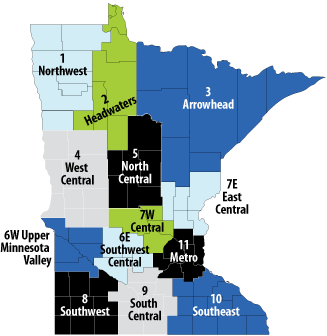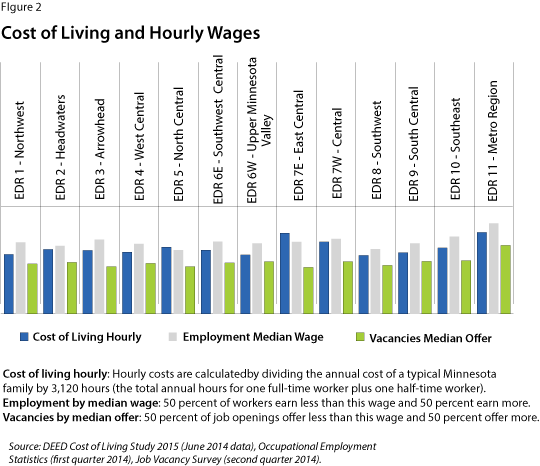by John Clay
March 2015
DEED's new Cost of Living tool can help employers decide how much to pay and workers determine whether their pay is enough to meet basic living expenses.
Minnesota, like other states, tracks wages to help paint a picture of the state economy. The median wage paid to employees in all occupations across the state is $18.15 per hour, according to first quarter 2014 data from the Occupational Employment Statistics survey. Half of all working Minnesotans are paid more and half are paid less. Nice to know. But how much money is $18.15? From a working person's perspective, is it enough to live on? And from an employer's perspective, is it enough to recruit and retain employees? Thanks to Minnesota's Cost of Living Study, we have a new tool to help us find answers.
The Cost of Living Study, available as an online tool, estimates basic living costs by county, region and statewide in seven categories: food, housing, health care, transportation, child care, other necessities and net taxes. Total costs are presented as yearly and hourly dollar amounts. The cost of living represents neither poverty nor a middle-class living but rather a living that meets basic needs for health and safety.
Although many factors contribute to a job's desirability, employers say demand-side conditions, including unsatisfactory wages, contribute to hiring difficulties in the production, industrial engineering, information technology and nursing occupations (see "Are Skilled Workers Scarce?" Minnesota Employment Review, June 2013).
In higher-wage occupations, where wages exceed the cost of basic needs, satisfaction is likely a response to whether wages are competitive within the occupation and industry. In lower-wage occupations, a more basic calculus may be involved for retention as well as hiring: Does the wage meet basic needs?
We'll take a broad look by comparing the cost of living to the median wage paid across all occupations and the median wage offer for job vacancies in Minnesota.
Looking at the state as a whole, a typical family of two adults and one child, with one adult working full time and one part time, for a combined 60 work hours per week, needs to earn an estimated family income of $50,988 per year and $16.34 per hour per worker to maintain a basic living, according to DEED's Cost of Living tool, using June 2014 data (see Figure 1).

The $18.15 median wage is 111 percent of the $16.34 cost of living, meaning that a little over half of all working Minnesotans are paid more than the family-of-three cost of basic needs.
If the labor market were in perfect balance - that is, everyone matched with the right jobs so that the half paid more than the median wage were the larger families and the half paid less were the smaller families - then a median wage equal to the cost of living would be enough to ensure the economy was meeting most people's basic needs. But economists know that no market is ever perfectly balanced.
In the real world, we look for a median wage that exceeds - by how much we can't say - the cost of living. The statewide median wage meets the test. And so do 11 of Minnesota's 13 economic development regions (see map).

The regions whose median wage is highest as a percentage of the cost of living are the Northwest at 120 percent, Upper Minnesota Valley at 119 percent, Arrowhead and Southeast at 117 percent, South Central at 115 percent, and West Central and Southwest Central at 113 percent. The Southwest and Metro match the state at 111 percent. Headwaters at 105 percent and Central at 104 percent lag behind the state figure while still slightly exceeding the cost of living. The North Central region at 95 percent and East Central at 89 percent both fall below the cost of living.
Looking at three years of Job Vacancy Survey data averaged together, ending with second quarter 2014 data, none of Minnesota's 13 economic development regions shows a median wage offer for vacancies that meets the cost of living (see Figure 2).

The numbers range from the Upper Minnesota Valley at 89 percent of the region's cost of living to East Central at 58 percent. The Northwest, Headwaters, West Central, Southwest Central, Upper Minnesota Valley, Southwest, South Central, Southeast and Metro all have job vacancy median wage offers above the statewide 79 percent of the cost of living. The Arrowhead, North Central, East Central and Central regions fall below the statewide share. But all fall below the cost of living for their own region.
Although median wage offers historically track lower than median wages for filled positions-perhaps because lower-wage jobs have higher turnover and might be captured more easily by the Job Vacancy Survey-a regional median wage offer below the regional cost of living may signal recruitment or retention challenges ahead.
The converse also is true: Median wages and wage offers that exceed the cost of living can signal a sustainable labor market that works for Minnesotans and for Minnesota employers.